Strand7 Software: In Detail: Moving Load: Load Paths
Moving load capabilities
| The Strand7 moving load module allows detailed specification and analysis of moving loads along prescribed load paths. The moving load module (a combination of a Load Path and a Load Path Template), combined with the load influence solver or one of the time-dependent solvers, offers a highly effective means of performing moving load analysis. | |
Load PathsMajor features | |
| |
|
Load Path Template A Load Path Template can contain multiple vehicles, which can be defined as point loads or distributed loads. While point loads can be grouped or floating, distributed loads can be leading, trailing, floating or grouped as per the different moving load codes. Coupled with this there can be leading and trailing load voids. The different loads can be assigned to define all vehicle templates specified by the codes; this includes HA and HB vehicular loads and railway loads as used in BS5400. The loads can be user defined, or imported from a standard load path template. Loads can also be defined in any direction in either the local or global coordinate systems, making it easy to define braking or centrifugal loads where required. | |
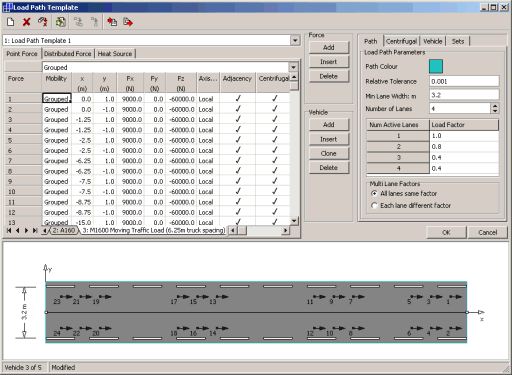
| |
Up to 16 lanes can be modeled and different factors can be applied to each lane if required. Lane factors may be applied to comply with various codes, e.g. AASHTO or AS 5100. These factors are considered if Adjacency is set in the load definitions. | |
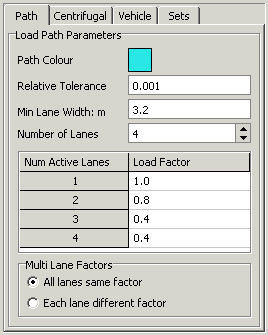
| |
Centrifugal loads can be applied to the load path automatically by entering an equation. This means that if the radius is changed, the loads don't have to be manually changed but instead will automatically update. Centrifugal loads are considered if Centrifugal is set in the load definitions. | |
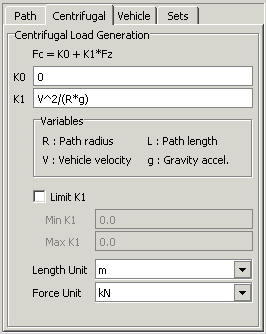
| |
Vehicles can also be single or multiple instance and may also straddle adjacent lanes. Both concentrated and distributed loads may act simultaneously on any lane. The velocity of the vehicle can be specified for dynamic analyses (such that the vehicle moves along the path), and is also used to calculate the centrifugal forces. | |
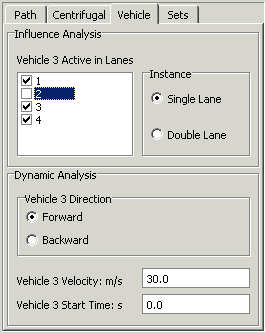
| |
Sets can be specified to ensure that vehicles are restricted in number if required, or that mutually exclusive vehicles do not accur at the same time. This is particularly useful in some Standards such as the British code. | |
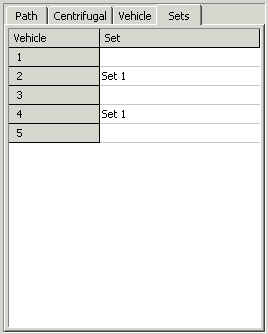
| |
Load paths can be created over any element type in Strand7. They can be straight or curved and are independent of the mesh density of the underlying elements. This means that if the load path only partially lies on one element then load will only be placed on part of the element. It also means that if the underlying mesh is changed, e.g. refined, then no additional work is required to define the load path. The load paths can also be easily modified at a later stage if required and can be copied, moved, scaled, etc, similarly to elements in Strand7. | |
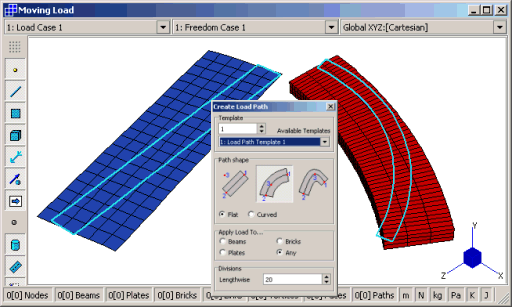
| |
Convert load paths to load cases Load Paths can be converted into Load Cases easily via a tool. The Load Cases will consist of vehicles at consecutive positions on each lane. This tool offers an alternative to the Load Influence approach to finding maximum results responses. | |
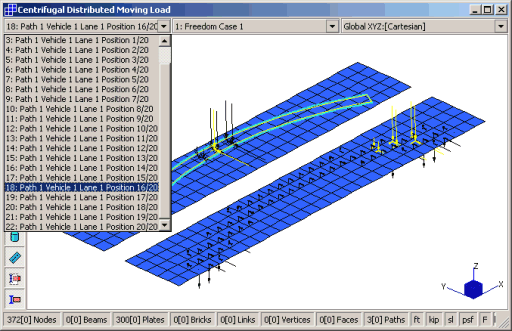
| |
|
For more information on moving load applications, see Strand7 Webnotes - Applications / Bridges. | |

 Menu
Menu